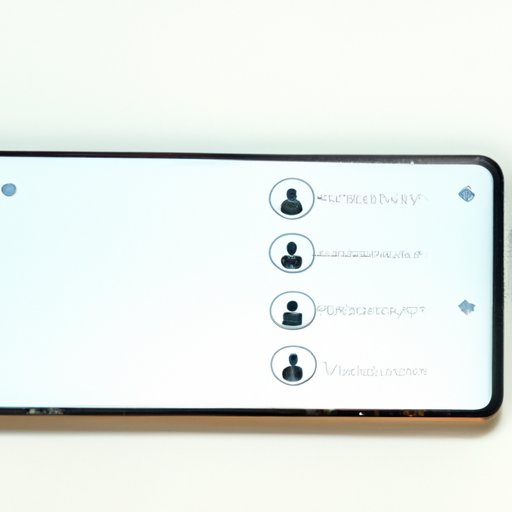
I. Introduction
Group chats can be both fun and helpful. But sometimes, they can become a source of frustration, distraction, and, in some cases, privacy issues. That’s why understanding how to leave a group chat on iPhone is essential for any iPhone user.
In this comprehensive guide, we’ll explore everything you need to know about leaving group chats on iPhone. We’ll cover the basics, introduce alternative solutions, emphasize privacy concerns, give tips on how to avoid offending others, offer alternatives, highlight productivity benefits, and provide examples of when to leave.
II. Start with the Basics: How to Leave a Group Chat on iPhone
If you’ve ever found yourself in a group chat that no longer suits your needs, you might be wondering how to leave it. Luckily, it’s easy to do so.
Here’s how:
- Open the group chat you want to leave.
- Tap the group name at the top of the screen.
- Scroll down and tap ‘Leave this Conversation.’
That’s it! You’ve successfully left the group chat. It’s important to note that after leaving the group, members can still see the messages you’ve sent.
III. Introduce Alternative Solutions
Leaving a group chat completely might not always be the best solution. For example, you might still want to be part of the chat but want to limit the notifications.
Here are some alternative solutions:
- Mute notifications: This option mutes the notifications for the group chat without leaving it.
- Customize alerts: Customize alerts allows users to customize the notifications for group chats they don’t want to miss—a great way to prioritize some chats over others.
These solutions come in handy when you still want to be part of the group chat but need it to be more manageable.
IV. Emphasize the Importance of Privacy
Privacy concerns can arise in group chats, from accidentally sharing private information to receiving unwanted messages. That’s why it’s essential to know when to leave the group chat to protect your privacy.
Here are some scenarios where leaving a group chat is the best course of action:
- You don’t know all of the members: If you’re not familiar with all the members of the chat, you might want to leave to avoid sharing personal information with strangers.
- Unwanted messages: If you’re receiving unwanted messages, especially from a member, leaving could be the best course of action.
- Sensitive topics: If the chat is discussing sensitive topics, you’re uncomfortable discussing it, or the conversation is no longer relevant to you. In that case, it’s best to leave the group chat.
However, before leaving the chat, consider discussing the issue with the chat’s creator or moderators to see if a solution can be reached to protect your privacy.
V. Give Tips on How to Avoid Offending Others
Leaving a group chat without causing rifts can be challenging, especially if you’ve been part of the chat for an extended period. Here are some tips on how to leave the chat politely without offending anyone:
- Explain your reasons: Be open and honest about why you’re leaving and how it’s affecting you.
- Private message: If you’re leaving due to a particular member, consider sending them a private message explaining your reasons instead of leaving abruptly.
- Acknowledge the group’s value: Let the members know you value the group and its members but can no longer be part of it.
VI. Offer Alternatives
Leaving the group chat doesn’t mean losing contact with the members. Here are some alternatives to consider:
- Social media platforms: Use social media platforms to keep in touch with members. Facebook, Instagram, and Twitter are great options.
- Virtual hangouts: Set up virtual hangouts for the whole group, using services like Zoom.
- Private messaging: Create individual channels to continue messaging individuals you regularly converse with on the group chat.
By finding a solution that works best for you, you can still stay connected with your favorite group members without being part of the chat.
VII. Highlight Productivity Benefits
Group chats can be a significant source of distraction, especially when you’re trying to get work done. Here are some ways leaving group chat can increase your productivity:
- Less distraction: You’ll no longer be bombarded with constant notifications
- More focus: Leaving the group means fewer conversations to monitor, allowing for more focus on important tasks.
- Enhanced work-life balance: By limiting distractions, you’re more likely to create a healthier work-life balance.
VIII. Provide Examples of When to Leave a Group Chat
Here are some common scenarios that could indicate it’s time for you to leave a group chat:
- If you’re no longer interested in the chat’s topics.
- If you find the chat to be a source of negativity or conflict.
- If you’re feeling overwhelmed by notifications or messages.
- If the chat’s creator or moderators are not responsive or addressing concerns.
Remember, it’s perfectly okay to leave a group chat, and in most cases, it’s the best course of action for your mental, emotional, and physical wellbeing.
IX. Conclusion
Leaving group chats on iPhone can be a simple yet challenging task, but it’s essential to protect your privacy and increase your productivity.
We’ve covered the basics of leaving group chats, introduced alternative solutions, emphasized the importance of privacy, given tips on how to avoid offending other members, offered alternatives, highlighted productivity benefits, and provided examples of when leaving a group chat is the best course of action.
Remember, there are plenty of digital communication alternatives to stay connected with group members. Find what works best for you and take action if you’re experiencing discomfort or frustration from being part of a group chat that no longer suits your needs.




